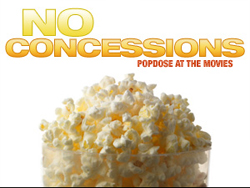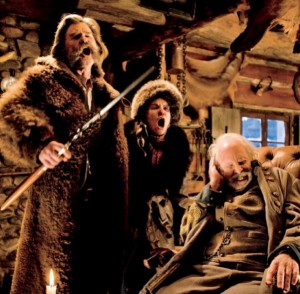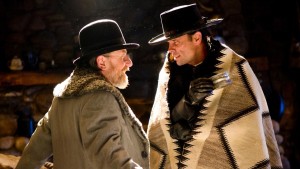 Eight observations about The Hateful Eight, which opens Christmas Day.
Eight observations about The Hateful Eight, which opens Christmas Day.
If you think you’ll recoil from the words “nigger,” “bitch,” “fuck,” and other obscenities, often (and I do mean often) colorfully combined for about 90 minutes, if (after an intermission) you think you’ll shrink from torture, dismemberment (teeth, testicles, etc.), and tremendous bloody violence (and more obscenities) for another 90 minutes…suffice it to say, The Hateful Eight is not a safe space for you this holiday season.
If you think you can make it without struggle, there are compensations. Viewed as a roadshow presentation, filmed in a widescreen format dormant for 50 years, cinephiles can get their geek on, enjoying the texture of film in our digital age. While much of the film does take place in a cabin setting, it’s a large cabin, and Robert Richardson’s camera prowls it expertly. But there are a good amount of scenic Old West vistas, too. It’s a nice gesture on writer/director Quentin Tarantino’s part, appreciated, though it doesn’t amount to much when the movie is on the same quality level as The Greatest Story Ever Told or The Hallelujah Trail, to name two other movies shot in Ultra Panavision 70.
Tarantino doesn’t do scores, preferring to needle-drop in singles and B-sides. (Sure, the movie’s set in the aftermath of the Civil War, but that doesn’t exclude The White Stripes, Roy Orbison, and actor David Hess’ rendition of “Now You’re All Alone,” from the horror hit The Last House on the Left, from being sampled. Tarantino’s period sense ends with the decor and the costumes.) He’s used a fair amount of Ennio Morricone music in his films, but this time he commissioned the maestro to supply new music (plus unused cues from The Thing and a bit of his Exorcist II: The Heretic score). The 87-year-old Morricone’s first score for a Western in almost 35 years, possibly his last, is more like his cop and gangster movie music than his legendary collaborations with Sergio Leone and other “spaghetti” filmmakers, and I regret there wasn’t more of it over the course of The Hateful Eight’s 187 (roadshow) minutes. His overture and main theme do an outstanding job setting the scene, however.
If by now you’re getting the idea that I’m looking for kind things to say about The Hateful Eight before moving in for the kill, you’re correct. Lacking much in the way of wit, the endless fusillade of bile and invective in the first half of this magnum octavus is more tiresome than titillating, and I dozed off for a few blessed minutes. The violence in the second half is more Evil Dead freakshow than impactful or meaningful, and Tarantino’s attempts to find something to say about all the bloodletting are strained. A political filmmaker he’s not–though he’s usually a more entertaining gutter poet.
 The Hateful Eight is essentially an extravagant two-part reboot of Reservoir Dogs (1992), the first part all set-up, the second payoff. Just as that film drew more than a little inspiration from the Hong Kong movie City on Fire (1987), the new one is liberally borrowed from a twisty TV Western from yesteryear. In the post-Civil War West, where titles, ranks, and loyalties are meaningless, a motley group of lawless travelers hunkers down in “Minnie’s Haberdashery” as a blizzard brews. Well before we get there the snarling, yelling, and name-calling have begun, and Tarantino has directed the actors to play their parts as broadly as possible. Some dust off their retired specialty acts–Bruce Dern, as a chair-bound general, hasn’t been this loony since the 70s, nor has Jennifer Jason Leigh, as a hangman-bound desperado, been so feral, going back to at least Last Exit to Brooklyn (1989). Tim Roth goes even further back, resurrecting the comedian Terry-Thomas for a feature-length imitation. It’s all too much. (And it’s more than a hateful eight, too–the opening credits reveal the movie’s Special Guest Star, who has trouble fitting in with the ensemble, and other actors besides, which gives away the Agatha Christie-ish plot line as your concentration wanders from the action. At least the filmmaker himself doesn’t appear, except that he does, in voiceover.)
The Hateful Eight is essentially an extravagant two-part reboot of Reservoir Dogs (1992), the first part all set-up, the second payoff. Just as that film drew more than a little inspiration from the Hong Kong movie City on Fire (1987), the new one is liberally borrowed from a twisty TV Western from yesteryear. In the post-Civil War West, where titles, ranks, and loyalties are meaningless, a motley group of lawless travelers hunkers down in “Minnie’s Haberdashery” as a blizzard brews. Well before we get there the snarling, yelling, and name-calling have begun, and Tarantino has directed the actors to play their parts as broadly as possible. Some dust off their retired specialty acts–Bruce Dern, as a chair-bound general, hasn’t been this loony since the 70s, nor has Jennifer Jason Leigh, as a hangman-bound desperado, been so feral, going back to at least Last Exit to Brooklyn (1989). Tim Roth goes even further back, resurrecting the comedian Terry-Thomas for a feature-length imitation. It’s all too much. (And it’s more than a hateful eight, too–the opening credits reveal the movie’s Special Guest Star, who has trouble fitting in with the ensemble, and other actors besides, which gives away the Agatha Christie-ish plot line as your concentration wanders from the action. At least the filmmaker himself doesn’t appear, except that he does, in voiceover.)
 Tarantino loves Walton Goggins, and I do, too, on TV shows like Justified and The Shield. His hair and teeth are made for Ultra Panavision 70; otherwise, he doesn’t really hold the screen in a leading part. The other castmembers, like Kurt Russell and Samuel L. Jackson, perform as expected, if uncomfortably cranked up. (Both were better in other recent, less touted releases, Russell in the excellent Bone Tomahawk, on DVD and Blu-ray next week, and Jackson showing surprising, and welcome, vulnerability as a besieged president in Big Game, plus his ringmaster role in Spike Lee’s Chi-raq.)
Tarantino loves Walton Goggins, and I do, too, on TV shows like Justified and The Shield. His hair and teeth are made for Ultra Panavision 70; otherwise, he doesn’t really hold the screen in a leading part. The other castmembers, like Kurt Russell and Samuel L. Jackson, perform as expected, if uncomfortably cranked up. (Both were better in other recent, less touted releases, Russell in the excellent Bone Tomahawk, on DVD and Blu-ray next week, and Jackson showing surprising, and welcome, vulnerability as a besieged president in Big Game, plus his ringmaster role in Spike Lee’s Chi-raq.)
Tarantino doesn’t go in for scoring, either, but here we have an actual sex scene of sorts, climaxing the first half of the movie. Reveling in his arrested adolescent swagger, it’s gross, vengeful rape sadism, overlong, not as funny as he thinks, and yet the fan boys in the audience squealed with delight at how “adult” and “taboo-busting” it is.
I’m tired of Quentin Tarantino. But not done with him. He’s made some terrific movies, just not this one or the equally overblown Django Unchained (2012). He says he wants to write and direct theater now, where he’ll be following the lead of Martin McDonagh (The Pillowman), who knows who to invest violence with genuine pain and significance. That’s something he did do, with his adaptation of Jackie Brown (1997), and it’s something he needs to get back to. Decked out though it is with Morricone music and Ultra-Panavision exotica, The Hateful Eight is just a wank.





Comments